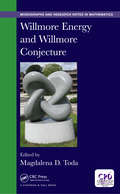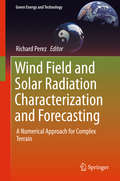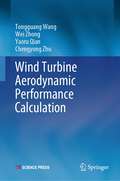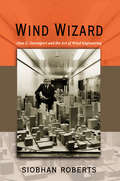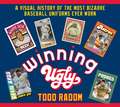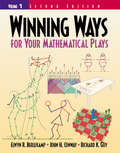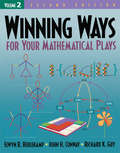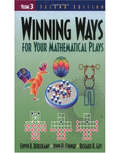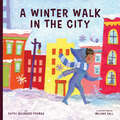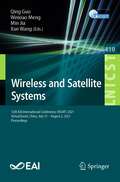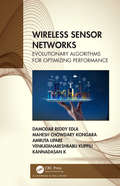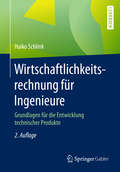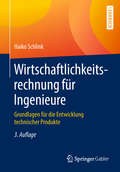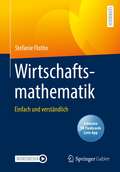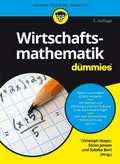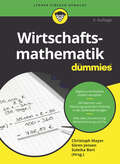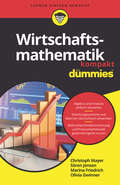- Table View
- List View
Willmore Energy and Willmore Conjecture (Chapman & Hall/CRC Monographs and Research Notes in Mathematics)
by Magdalena D. TodaThis book is the first monograph dedicated entirely to Willmore energy and Willmore surfaces as contemporary topics in differential geometry. While it focuses on Willmore energy and related conjectures, it also sits at the intersection between integrable systems, harmonic maps, Lie groups, calculus of variations, geometric analysis and applied differential geometry. Rather than reproducing published results, it presents new directions, developments and open problems. It addresses questions like: What is new in Willmore theory? Are there any new Willmore conjectures and open problems? What are the contemporary applications of Willmore surfaces? As well as mathematicians and physicists, this book is a useful tool for postdoctoral researchers and advanced graduate students working in this area.
Wind Field and Solar Radiation Characterization and Forecasting: A Numerical Approach For Complex Terrain (Green Energy And Technology)
by Richard PerezIn addition to describing core concepts and principles, this book reveals professional methodologies and tools used by national agencies and private corporations to predict sites’ potential for wind and solar power generation. Each chapter focuses on a different issue, showing readers the corresponding methodology, as well as examples of how to apply the techniques described. These techniques are explained with step-by-step guides that demonstrate how environmental variables in complex terrains can be characterized and forecasted.The authors present an adaptive finite element mass-consistent model, which computes a diagnostic wind field in the three-dimensional area of interest using observed wind data from measurement stations – data which is then interpolated using a physical model of the wind field in the boundary layer. An ensemble method is presented based on the perturbation of the numerical weather prediction models’ results. The book goes on to explain solar radiation characterization and forecasting. Solar radiation and electrical power generation temporal and spatial variability are discussed and modelled. Different statistical methods are presented in order to improve solar radiation forecasting using ground measurement, numerical weather predictions (NWPs) and satellite-derived data. This book is focused on both probabilistic and point forecast explaining different models and methodologies to improve the forecasting. The results obtained from various simulations around the world are presented in tables. Finally, the book explains a possible methodology to develop a Solar Map taking into account solar radiation, terrain surface conditions and cast shadows.As such, the book provides an overview of the concepts, principles and practices involved in the treatment of environmental variables related to solar radiation or wind fields, especially when complex terrains are involved, offering useful resources for students and researchers alike. It also equips professionals with the methodologies and tools needed to construct environmental variable maps and conduct forecasting for solar radiation and wind fields.
Wind Resistant Design of Bridges in Japan
by Hiroshi Tanaka Kichiro Kimura Yozo FujinoFor long-span bridges, wind action is a dominant factor in their safety and serviceability. A large number of long-span bridges have been built in Japan over the past 30 years, and tremendous amounts of research and technical development have been accomplished in wind-resistant design. This book is a compilation of the results of active research and development. Wind-resistant design standards generated in Japan are described in the first few chapters. Then comes information such as design wind speed, structural damping, wind tunnel tests, and analyses, which provide the basis of the design standards. Wind-induced vibrations and their control of girders, towers, cables, and other features are explained with examples of field measurements. Comprehensive listings of Japanese experience in vibration control are also presented. Because achieving particularly dynamic safety against wind is still not an easy task, these data and information will be valuable assets for the wind-engineering and bridge-engineering communities.
Wind Turbine Aerodynamic Performance Calculation
by Tongguang Wang Wei Zhong Yaoru Qian Chengyong ZhuThis book deals with horizontal-axis wind turbine aerodynamic performance prediction methods. It focuses on the traditional and newly-developed methods for the wind turbine aerodynamic performance calculation. The fundamental theories of fluid mechanics essential for understanding the other parts of this book are firstly introduced in Part I, followed by the blade element momentum theory in Part II, with special attentions to a systematic review of various correction models. Part III is mainly about the prescribed and free vortex wake methods, while the state-of-art computational fluid dynamics (CFD) methods are detailed in Part IV.Part III thoroughly describes the prescribed and free vortex wake methods which are still of great importance towards realistic investigation of wind turbine performance. Despite the highly computational cost, the CFD methods in Part IV have received increasing interest from the academic community since they provide more detailed information about the flow field around the wind turbine. This has shed a light in combination with the correction models introduced in Part II on more advanced research for wind turbine.This book is intended for researchers and students interested in aerodynamics of wind turbine and is particularly suitable for practicing engineers in wind energy. Readers can gain a comprehensive understanding in both classical and up-to-date methods for the study of wind turbine aerodynamics. The authors hope that this book can promote the research and development of wind turbines.
Wind Wizard
by Siobhan RobertsWith Wind Wizard, Siobhan Roberts brings us the story of Alan Davenport (1932-2009), the father of modern wind engineering, who investigated how wind navigates the obstacle course of the earth's natural and built environments--and how, when not properly heeded, wind causes buildings and bridges to teeter unduly, sway with abandon, and even collapse. In 1964, Davenport received a confidential telephone call from two engineers requesting tests on a pair of towers that promised to be the tallest in the world. His resulting wind studies on New York's World Trade Center advanced the art and science of wind engineering with one pioneering innovation after another. Establishing the first dedicated "boundary layer" wind tunnel laboratory for civil engineering structures, Davenport enabled the study of the atmospheric region from the earth's surface to three thousand feet, where the air churns with turbulent eddies, the average wind speed increasing with height. The boundary layer wind tunnel mimics these windy marbled striations in order to test models of buildings and bridges that inevitably face the wind when built. Over the years, Davenport's revolutionary lab investigated and improved the wind-worthiness of the world's greatest structures, including the Sears Tower, the John Hancock Tower, Shanghai's World Financial Center, the CN Tower, the iconic Golden Gate Bridge, the Bronx-Whitestone Bridge, the Sunshine Skyway, and the proposed crossing for the Strait of Messina, linking Sicily with mainland Italy. Chronicling Davenport's innovations by analyzing select projects, this popular-science book gives an illuminating behind-the-scenes view into the practice of wind engineering, and insight into Davenport's steadfast belief that there is neither a structure too tall nor too long, as long as it is supported by sound wind science.
Windows to Algebra and Geometry: An Integrated Approach
by Ron LarsonAs you study this book you will be able to understand the value and purpose of what you are learning. That's why the book begins each lesson explaining what you should learn and why you should learn it.
Winning Ugly: A Visual History of the Most Bizarre Baseball Uniforms Ever Worn
by Todd RadomBaseball, our national pastime. Every fan has memories of their team’s incredible victories and anguishing defeats. We remember the home runs, the walk-off wins, and the moments that will last a lifetime. We also remember those things which we wish we could forget: the errors, the mental mistakes . . . and the ugly uniforms.In an ode to those eyesores, Todd Radom has collected and chronicled some of the swing-and-misses we’ve ever seen on the baseball diamond. Remember when the Chicago White Sox thought wearing shorts in 1977 was a good idea? How about when the Baltimore Orioles wore their all-orange jerseys in 1971? Do you remember the 1999 “Turn Ahead the Clock” campaign? Or the most recent all-camo jerseys of San Diego Padres?Yes, there is much to talk about when it comes to the odd uniform decisions teams have made over the years. But just like there’s love out there for French bulldogs or Christmas sweaters, ugly uniforms hold a warm place in the heart of all baseball fans.Sure they didn’t affect wins and losses (unless you mention Chris Sale), but a fan’s love and ire goes well beyond the current standings. So whether your team appears in Ugly Baseball Uniforms or not, fans of the sport will enjoy reliving the moments most teams would like to forget.
Winning Ways for Your Mathematical Plays: Volume 1
by Elwyn R. Berlekamp John H. Conway Richard K. GuyThis classic on games and how to play them intelligently is being re-issued in a new, four volume edition. This book has laid the foundation to a mathematical approach to playing games. The wise authors wield witty words, which wangle wonderfully winning ways. In Volume 1, the authors do the Spade Work, presenting theories and techniques to "dissect" games of varied structures and formats in order to develop winning strategies.
Winning Ways for Your Mathematical Plays, Volume 2: Volume 1 (AK Peters/CRC Recreational Mathematics Series)
by John H. Conway Elwyn R. Berlekamp Richard K. GuyIn the quarter of a century since three mathematicians and game theorists collaborated to create Winning Ways for Your Mathematical Plays, the book has become the definitive work on the subject of mathematical games. Now carefully revised and broken down into four volumes to accommodate new developments, the Second Edition retains the original's wealth of wit and wisdom. The authors' insightful strategies, blended with their witty and irreverent style, make reading a profitable pleasure. In Volume 2, the authors have a Change of Heart, bending the rules established in Volume 1 to apply them to games such as Cut-cake and Loopy Hackenbush. From the Table of Contents: - If You Can't Beat 'Em, Join 'Em! - Hot Bottles Followed by Cold Wars - Games Infinite and Indefinite - Games Eternal--Games Entailed - Survival in the Lost World
Winning Ways for Your Mathematical Plays, Volume 3: Volume 1 (AK Peters/CRC Recreational Mathematics Series)
by John H. Conway Elwyn R. Berlekamp Richard K. GuyIn the quarter of a century since three mathematicians and game theorists collaborated to create Winning Ways for Your Mathematical Plays, the book has become the definitive work on the subject of mathematical games. Now carefully revised and broken down into four volumes to accommodate new developments, the Second Edition retains the original's wealth of wit and wisdom. The authors' insightful strategies, blended with their witty and irreverent style, make reading a profitable pleasure. In Volume 3, the authors examine Games played in Clubs, giving case studies for coin and paper-and-pencil games, such as Dots-and-Boxes and Nimstring. From the Table of Contents: - Turn and Turn About - Chips and Strips - Dots-and-Boxes - Spots and Sprouts - The Emperor and His Money - The King and the Consumer - Fox and Geese; Hare and Hounds - Lines and Squares
Winter Walk in the City (In The City Ser.)
by Cathy Goldberg FishmanFollow this adventure through the city in the winter, and peek into the windows to explore multicultural winter holidays.
Wireless and Satellite Systems: 12th EAI International Conference, WiSATS 2021, Virtual Event, China, July 31 – August 2, 2021, Proceedings (Lecture Notes of the Institute for Computer Sciences, Social Informatics and Telecommunications Engineering #410)
by Qing Guo Weixiao Meng Min Jia Xue WangThis book constitutes the refereed post-conference proceedings of the 12th International Conference on Wireless and Satellite Services, WiSATS 2021, held in Nanjing, China, in September 2020. Due to COVID-19 pandemic the conference was held virtually. The 79 full papers were carefully reviewed and selected from 140 submissions. The conference’s central theme is the means of using the wireless and satellite services directly to the user for personal communications, multimedia and location identification. The services enabled by WiSATS not only cover the requirements of an ordinary citizen but also provide personal and public services for global coverage communications as the applications of internet of things.
Wireless Sensor Networks: Evolutionary Algorithms for Optimizing Performance
by Damodar Reddy Edla Mahesh Chowdary Kongara Amruta Lipare Venkatanareshbabu Kuppili Kannadasan KWireless Sensor Networks: Evolutionary Algorithms for Optimizing Performance provides an integrative overview of bio-inspired algorithms and their applications in the area of Wireless Sensor Networks (WSN). Along with the usage of the WSN, the number of risks and challenges occurs while deploying any WSN. Therefore, to defeat these challenges some of the bio-inspired algorithms are applied and discussed in this book. Discussion includes a broad, integrated perspective on various challenges and issues in WSN and also impact of bio-inspired algorithms on the lifetime of the WSN. It creates interdisciplinary theory, concepts, definitions, models and findings involved in WSN and Bio-inspired algorithms making it an essential guide and reference. It includes various WSN examples making the book accessible to a broader interdisciplinary readership. The book offers comprehensive coverage of the most essential topics, including: Evolutionary algorithms Swarm intelligence Hybrid algorithms Energy efficiency in WSN Load balancing of gateways Localization Clustering and routing Designing fitness functions according to the issues in WSN. The book explains about practices of shuffled complex evolution algorithm, shuffled frog leaping algorithm, particle swarm optimization and dolphin swarm optimization to defeat various challenges in WSN. The author elucidates how we must transform our thinking, illuminating the benefits and opportunities offered by bio-inspired approaches to innovation and learning in the area of WSN. This book serves as a reference book for scientific investigators who shows an interest in evolutionary computation and swarm intelligence as well as issues and challenges in WSN.
Wirkungen von Fortbildungen zum Thema Rechenschwäche auf fachdidaktische Fähigkeiten und motivationale Orientierungen: Professionalisierung von Mathematik unterrichtenden Lehrpersonen
by Mark SprengerMark Sprenger untersucht die Wirkungen unterschiedlich konzipierter Fortbildungen zum Thema Rechenschwäche unter dem Blickwinkel der Professionalisierung von Lehrpersonen. Im Fokus der Untersuchung stehen dabei vor allem die Kompetenzen von Lehrerinnen und Lehrern im Zusammenhang mit der Diagnose und Förderung von Kindern mit besonderen Schwierigkeiten beim Rechnenlernen. Um diese Kompetenzen quantitativ und handlungsnah zu erfassen, wird ein auf Videovignetten basierendes Instrument entwickelt. Neben den Wirkungen auf die diagnostischen Fähigkeiten und Förderfähigkeiten von Lehrpersonen werden in der Untersuchung auch Wirkungen von Fortbildungen auf die motivationalen Orientierungen Enthusiasmus und Selbstwirksamkeit in den Blick genommen.
Wirtschaftlichkeitsrechnung für Ingenieure
by Haiko SchlinkDieses Lehrbuch macht Studierende und Lehrende aller Ingenieurdisziplinen mit den für sie relevanten betriebswirtschaftlichen Grundlagen und Methoden vertraut. Da die Entwicklung neuer Produkte meist langwierig und mit hohem Geldeinsatz verbunden ist, wird es immer wichtiger, dass sich Ingenieure systematisch mit der Entscheidungsfindung auseinandersetzen. Andernfalls besteht die Gefahr, dass wichtige Dinge „aus dem Bauch heraus“ entschieden werden und wesentliche Vorstellungen des Unternehmens unberücksichtigt bleiben. Studierende, Lehrende und interessierte Praktiker erfahren, wie sie die Wirtschaftlichkeit von Produktentwicklungen oder -änderungen entwicklungsmethodisch nachhaltig verbessern.Neben anschaulichen Beispielen sind zur Einübung des Stoffes jedem Abschnitt Fragen zur Wiederholung und Vertiefung sowie Übungsaufgaben mit Lösungen zugeordnet.Die 2. Auflage wurde gründlich überarbeitet und insbesondere das erste Kapitel thematisch erweitert und ergänzt.Das Buch enthält ein Geleitwort von em. Univ.-Prof. Dr. oec. habil. Herfried M. Schneider.
Wirtschaftlichkeitsrechnung für Ingenieure: Grundlagen für die Entwicklung technischer Produkte
by Haiko SchlinkDieses Lehrbuch macht Studierende und Lehrende aller Ingenieurdisziplinen mit den für sie relevanten betriebswirtschaftlichen Grundlagen und Methoden vertraut. Da die Entwicklung neuer Produkte meist langwierig und mit hohem Geldeinsatz verbunden ist, wird es immer wichtiger, dass sich Ingenieure systematisch mit der Entscheidungsfindung auseinandersetzen. Andernfalls besteht die Gefahr, dass wichtige Dinge „aus dem Bauch heraus“ entschieden werden und wesentliche Vorstellungen des Unternehmens unberücksichtigt bleiben. Studierende, Lehrende und interessierte Praktiker erfahren, wie sie die Wirtschaftlichkeit von Produktentwicklungen oder -änderungen entwicklungsmethodisch nachhaltig verbessern.Neben anschaulichen Beispielen sind zur Einübung des Stoffes jedem Abschnitt Fragen zur Wiederholung und Vertiefung sowie Übungsaufgaben mit Lösungen zugeordnet. Für die 3. Auflage wurden insbesondere die Bereiche Kostenkalkulation, Produktentwicklung als Investition und betriebswirtschaftliche Entscheidungslehre gründlich überarbeitet und thematisch erweitert.Das Buch enthält ein Geleitwort von Univ.-Prof. em. Dr. habil. Herfried M. Schneider.
Wirtschaftsmathematik: Einfach und verständlich
by Stefanie FlothoDieses Lehrbuch richtet sich an alle, die Wirtschaftsmathematik im Grundstudium belegen müssen (aber vielleicht nicht immer möchten). Konzepte der Analysis und linearen Algebra im Rahmen einer einsemestrigen Vorlesung werden auf einer anwendungsorientierten Ebene erläutert. Im Vordergrund steht die Anwendung von Formeln und Konzepten, auf langwierige Herleitungen und Beweise wird verzichtet. Die Methoden werden schrittweise erklärt und mit detaillierten Beispielen und vielen Zwischenergebnissen vorgeführt. Daher sind sie gerade auch für diejenigen Studierenden besonders lesenswert und hilfreich, deren Kontakt mit Mathematik bereits einige Jahre zurückliegt.
Wirtschaftsmathematik für Dummies (Für Dummies)
by Christoph Mayer Sören Jensen Suleika BortMathematik ist für viele angehende Wirtschaftswissenschaftler ein notwendiges Übel, dabei ist es gar nicht so schwer, wie Sie vielleicht denken. In "Wirtschaftsmathematik für Dummies" vermitteln Ihnen die Autoren genau die Mathematikkenntnisse, die für Sie als Wirtschaftswissenschaftler relevant sind. Ob Gleichungen, Differentiation und Integration, Matrizen oder Zins- und Rentenrechnung - werden Sie zum Experten! Dank Beispielen und Schritt-für-Schritt-Erklärungen lernen Sie außerdem, wie Sie Ihre Kenntnisse in der Praxis anwenden. So kann die nächste Prüfung kommen!
Wirtschaftsmathematik für Dummies (Für Dummies)
by Christoph Mayer Sören Jensen Suleika BortMathematik ist für viele angehende Wirtschaftswissenschaftler ein notwendiges Übel, dabei ist es gar nicht so schwer, wie Sie vielleicht denken. In "Wirtschaftsmathematik für Dummies" vermitteln Ihnen die Autoren genau die Mathematikkenntnisse, die für Sie als Wirtschaftswissenschaftler relevant sind. Ob Gleichungen, Differentiation und Integration, Matrizen oder Zins- und Rentenrechnung - werden Sie zum Experten! Dank Beispielen und Schritt-für-Schritt-Erklärungen lernen Sie außerdem, wie Sie Ihre Kenntnisse in der Praxis anwenden. So kann die nächste Prüfung kommen!
Wirtschaftsmathematik kompakt für Dummies (Für Dummies)
by Christoph Mayer Sören Jensen Marina Friedrich Olivia GwinnerMüssen Sie sich schnell in die Wirtschaftsmathematik einarbeiten? Dieses handliche Buch bietet Ihnen einen Kompaktkurs in die wichtigsten mathematischen Grundlagen, die Sie kennen müssen, wenn Sie im wirtschaftlichen Umfeld unterwegs sind: Algebra und Analysis, Wahrscheinlichkeitsrechnung und Finanzmathematik. Anhand von Beispielen aus der Wirtschaftspraxis werden mathematische Zusammenhänge erklärt und veranschaulicht, sodass Sie sich schnell schlau machen können.
